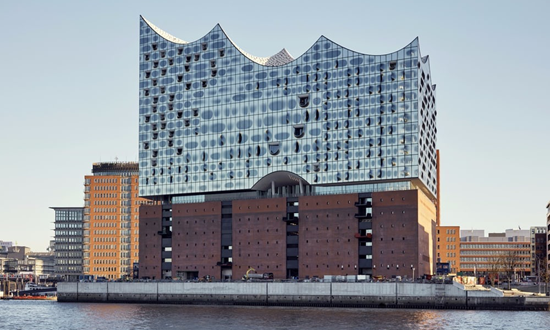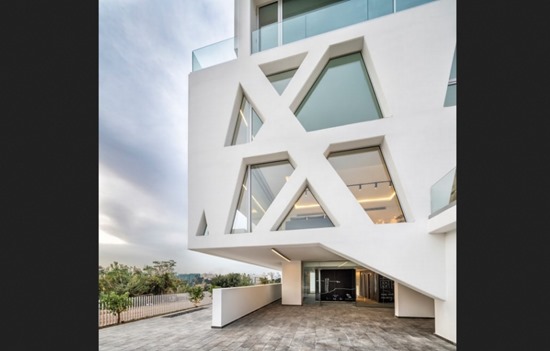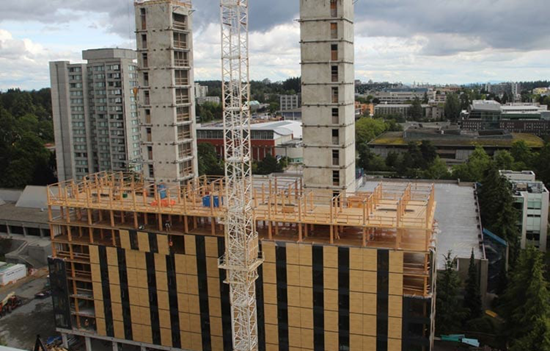
Floating digs to alien spaceships: The best buildings of 2016
By Adam Williams, New Atlas, 21 December 2016.
By Adam Williams, New Atlas, 21 December 2016.
2016 has been a bumper year for architecture and our coverage has included some amazing projects both big and small from around the globe. Join us as we take a look at the 10 best buildings we've reported on in the past 12 months, including the world's second-tallest skyscraper, a first 3D-printed office, floating student housing, and an out-of-this-world opera house.
1. One World Trade Center
With the emotional baggage involved, a worthwhile successor to the original World Trade Center seemed a very difficult project, but Skidmore, Owings & Merrill pulled it off brilliantly with the One World Trade Center.
Rising to a symbolic height of 1,776 ft (541 m), the One World Trade Center is a genuine landmark for NYC. The design of the crystalline building is informed by city's golden-era skyscrapers, such as the Chrysler Building and boasts a podium sporting decorative glass fins rising to an octagon at its center, before culminating with a spire.
The supertall skyscraper's green credentials are impressive, too. Stormwater run-off is captured and stored for cooling and irrigation, over 40 percent of the materials used in construction were recycled, and the tower's elevators can reclaim energy through regenerative braking to reduce demand on the grid.
2. Harbin Opera House
We're cheating a little bit by including this project in a 2016 roundup as we covered it just at the close of 2015, but it would be a great shame for MAD's masterful Harbin Opera House to slip through the cracks.
The product of a winning architectural competition entry back in 2010, Harbin Opera House occupies a total footprint of 850,000 sq ft (78,967 sq m) and consists of two high-end theaters with a combined capacity of 2,000 patrons.
Located in the wetlands of Northeast China, the building looks like an alien spaceship has landed. Its design also brings to mind Zaha Hadid, which is fitting as MAD's founder Ma Yansong once worked under the late starchitect.
Its façade consists of smooth white aluminum panels and glazed areas, culminating in a crowning glass feature over the grand lobby. Inside, visitors are treated to a Grand Theater beautifully sculpted from Manchurian Ash.
3. Mausoleum of the Martyrdom of Polish Villages
Poland's Nizio Design Internationale designed the Mausoleum of the Martyrdom of Polish Villages to commemorate the many rural Polish victims of the Nazi occupation during the Second World War.
A large project including extensive landscaping, its centerpiece is a row of 11 house-shaped buildings which begin as fully-formed and degrade into a skeletal framework, depicting the destruction and loss of life.
Inside, visitors walk through a series of multimedia exhibitions, with subjects including the Polish resistance movement, the murder of civilians, and deportation and forced labor. The final stage of this emotionally-charged experience shows the Nazi war criminals themselves, before the mausoleum breaks up completely and disappears.
4. Via 57 West
Starchitect Bjarke Ingels is very much the man of the moment in architecture circles and his Danish firm BIG has launched a number of projects in the United States that are raising his profile even further. The most significant of these is Via 57 West, a plush residential building in Manhattan.
Via 57 West brings together all that's best about BIG: unconventional, original, and daring, the 32-story tetrahedral building is a melding of a skyscraper and a housing block with central courtyard (thus the "courtscraper" nickname). From one angle it resembles a pyramid and from another a ship's sail voyaging down the Hudson River.
The courtyard itself is modeled after NYC's Central Park and has the exact same proportions, but at one 13,000th the size. Via 57 West's odd dimensions also increase sunlight for those using it and ensure choice views of the Hudson.
5. Shanghai Tower
Recently declared the world's best new skyscraper by Emporis, Gensler's Shanghai Tower has also picked up numerous other awards - in addition to bragging rights as the world's second-tallest building.
The twisting supertall skyscraper rises an impressive 632 m (2,073 ft) over Shanghai and cost US$2.4 billion to construct. It took six years to build and sports a double-glass wall that twists a full 120 degrees to mitigate the battering winds that buildings face at such heights.
The size of the project is stupendous. It rests upon 1,079 concrete and steel piles, and its foundations involved a fleet of trucks pouring concrete for 63 hours straight. Its 218 floors comprise 420,000 sq m (4,520,842 sq ft) of floor space.
Shanghai Tower's façade has a total of 270 wind turbines that provide the power needed for external lighting. The building's funnel-shaped parapet channels rainwater for the air-conditioning and heating systems, and a greywater system is also installed.
6. Elbphilharmonie
Situated atop an existing warehouse on the banks of the river Elbe in Hamburg, Germany, Herzog & de Meuron's Elbphilharmonie is a remarkable concert hall that also includes a hotel, and 45 private apartments.
Its eye-catching façade consists of roughly 1,100 panes of glass, each measuring 4-5 m (13-16 ft) wide and over 3 m (10 ft) high. Sculpted with precision, the façade is marked with grey reflective dots which stop the sunlight from overheating the building and create its signature shimmering look.
The Elbphilharmonie is just as impressive inside as out and its centerpiece, the Grand Hall, includes an orchestra pit in the middle and tiered seating for up to 2,100.
7. The Cube
Rising to a total height of 50 m (164 ft) in the east of Beirut, Lebanon, Orange Architects' The Cube features 14 stacked volumes which rotate 90 degrees per level, providing generous sheltered balconies to its residents.
Structurally, the building consists of a fixed core containing elevators and staircases which are crossed by concrete girders. Inside, it comprises a total floor space of 5,600 sq m (60,277 sq ft), split between 19 luxury apartments.
The homes boast large terraces with fantastic views of the Mediterranean and the city's skyline. Parking lies underground and a large section of the building cantilevers over the main entrance.
8. Urban Rigger
Another project by BIG, Urban Rigger sees the firm using recycled shipping containers to produce a sustainable floating student housing prototype for Copenhagen that it hopes to replicate elsewhere.
Urban Rigger comprises nine recycled shipping containers arranged into housing, a common winter garden/courtyard, kayak landing point, bathing platform, BBQ area, and seating. There's a total of 680 sq m (7,319 sq ft) of floor space available.
Inside, the container apartments look a lot more appealing to live in than many of the rundown student digs that dot our major cities. Electricity is produced by a roof-based solar array, while a heat exchanger system uses the seawater it floats on to efficiently heat and cool the interiors.
9. Brock Commons
The new student residence building at the University of British Columbia in Canada, Brock Commons, serves as an excellent example of tall wood building done right.
The environmentally-friendly and attractive student accommodation contains 33 four-bed units and 272 studios spread over 18 floors, housing a total of 404 residents. Structurally, it comprises 16 floors of cross laminated timber floor panels, in addition to a steel-framed roof, and concrete base and stairwells.
The building's attractive façade consists of prefabricated panels, which have the windows pre-installed. It rose remarkably quickly and, after finding their feet in the first week, the builders were able to progress at a rate of two or more floors per week (not including the concrete sections or steel roof), finishing the building's wooden structure ahead of schedule.
Brock Commons is designed to attain the LEED Gold certification green building standard once it's fully completed, which is slated for May, 2017.
10. Office of the Future
Having already positioned itself at the forefront of tall building design with the world's tallest skyscraper, the Burj Khalifa, Dubai is now at the cutting edge of 3D-printed architecture too, with its Office of the Future.
Hailed as the world's first 3D-printed office, the building takes up a footprint of 250 sq m (2,690 sq ft) within Dubai's Emirates Towers complex and will serve as a fully-functional office.
A very large 3D printer measuring 20 x 120 x 40 ft (6 x 36 x 12 m) constructed the office by extruding a cement mixture layer by layer. There were also some additional smaller mobile 3D-printers used, and the process took 17 days.
That completes our selection of this year's best buildings. Head to the gallery for a closer look at each of the projects.










No comments:
Post a Comment
Please adhere to proper blog etiquette when posting your comments. This blog owner will exercise his absolution discretion in allowing or rejecting any comments that are deemed seditious, defamatory, libelous, racist, vulgar, insulting, and other remarks that exhibit similar characteristics. If you insist on using anonymous comments, please write your name or other IDs at the end of your message.